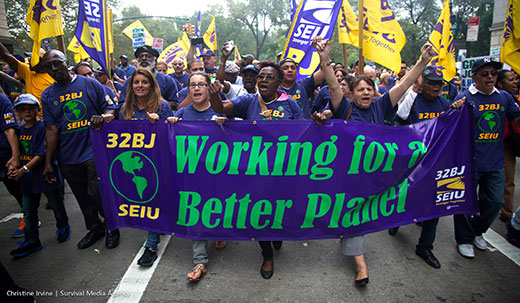
NEW YORK – In the midst of the 400,000 who participated in the Sept. 21 People’s Climate March here, there were many trade unionists. Six national unions, numerous state labor federations and central labor councils, plus as many as 50 local unions took part in the largest climate march in history.
The union workers, alongside many thousands of others, filled the streets of Manhattan’s East Side for much of the day, demanding that U.S. and world leaders act to divest from fossil fuels and combat climate change. They did so a day ahead of the UN Climate Summit, which is being attended by 120 world leaders including President Obama.
In the city itself, the American Federation of State, County, and Municipal Employees played a major role in organizing marchers, amongst whom were community coalitions, women’s groups, and a host of progressive organizations. Unions worked with these groups and many other allies, coming together to demand international action to curb the factors that cause global warming, including carbon and methane emissions. In particular, a major focus for unions was environmental justice. They pointed to the fact that workers, those in poverty, and minorities are often the victims of pollution and toxic waste. Even when it comes to national disasters caused by climate change, they added, it is most often working people who suffer the most.
“I think this climate march is awesome,” said Audra Makuch, executive assistant to the regional director of the New York area United Food and Commercial Workers. “There’s so many people; a super diverse crowd. Labor has a strong presence here, and there’s a good reason for that. A lot of union members worked super hard to turn out for this event. The UFCW is here, and the SEIU. And National Nurses United brought buses of workers down. Any of them will tell you, climate change is a working person’s issue. The working class bears the brunt of problems resulting from it. So this is really important for any worker.”
Among labor’s other participants in the march were the Amalgamated Transit Union; Communications Workers; the Office and Professional Employees; the Retail, Wholesale, and Department Store Workers; the National Education Association; the Service Employees, and the NNU. Also active in the march were members of the Canadian Labor Congress and UNI, an international federation that includes U.S. unions.
Other union backers included locals and state councils of SEIU and the American Federation of Teachers; UFCW; the National Writers Union; UAW; Teamsters Joint Council 16 and Locals 805 and 814; a heat and frost insulators’ local; a large New York City Transport Workers local; IBEW Local 3 from Queens; the Blue-Green Alliance; the National Domestic Workers Alliance; and the Labor Council for Latin American Advancement (LCLAA – the AFL-CIO constituency group for Hispanic workers).
Union marchers also showed disdain for corporations whose frequent policies of inaction and denial on climate matters often result in dangerous pollution.
Makuch added that union marchers also saw the issues of jobs and of the environment as one and the same. “There are good potential union jobs in clean energy,” she remarked. “There’s no reason why it can’t happen, we just have a lot of work to do. And don’t forget – farmworkers and grocery workers are directly connected to the environment, and they’re already union workers. So I would stand with them in saying that we need to prioritize clean energy instead of fossil fuels.”
Greg Zuber, percussionist with the Met Opera Local 802, said, “You can’t have much of an economy without clean energy. So I would say to anyone who buys the Republican line that renewables won’t provide jobs: Stop believing the disinformation campaign. The continued reliance on fossil fuels, that’s something that will affect my kids and grandkids; it’s not worth the risk.”
Jason Haaheim, a timpanist also with the Met Opera Local 802, added, “The so-called division between jobs and environment – to me, that’s a false dichotomy. The solutions for reducing carbon and methane emissions are not only revenue-neutral, but revenue producing.”
Mark Gruenberg contributed to this story.
Photo: Christine Irvine/People’s Climate March/Flickr












Comments